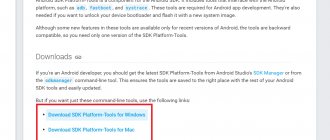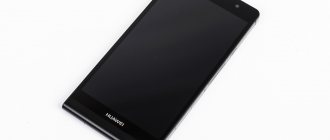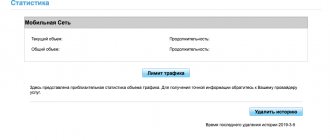Firmware Huawei Ascend P1 LTE
First of all, let's figure out how to update the software if it is not the latest. The firmware can be downloaded from the Huawei website (link) or from Mega (link), at the moment (01/20/2014) the latest version is V100R001C00B120. You can check the installed version through the “Settings” menu, then “About phone”, and there is the very last item “Build number”. If at the end “1V100R001C00B120”, then the version is the latest, and nothing needs to be updated; if we see there that the version is different (the last three-digit number is less), then it’s worth updating.
To update you need to do the following steps:
1) Download the software from the manufacturer’s website (link), after downloading is complete, extract the data from the archive.
2) After extracting the archive, in the folder that appears we will find instructions in English and the “update.app” firmware file in the “dload” subfolder.
3) On the memory card, you need to create a directory named “dload” and copy the firmware file “update.app” into it (to do this, connect the phone in storage mode to the computer). First copy all data from the internal memory of your smartphone to a computer or external memory card - during the firmware process, all data from the internal memory will be deleted.
4) Now go to the “Settings” menu, then “Memory” and there select “Software Update”, then “SD Card Update”, then “Confirm”, and finally “Update”. After clicking the final “Update”, the phone will reboot and the update will begin. The process takes ~3-4 minutes.
5) After turning on the phone, you will see the usual Android welcome menu.
Getting root on Huawei Ascend P1 LTE
All official firmware out of the box does not require root access. But if necessary, it is quite easy to get it.
So, what needs to be done to get root on Huawei Ascend P1 LTE:
1) Download the Kingo Android Root program (works on Windows XP/Vista/7/8), you can download it from the official website - link, or from Mega - link (after downloading, you need to extract it from the archive). There were rumors that the program could steal IMEI, but the rumors have not yet been confirmed, but of course - you use the program only at your own peril and risk. We wait for the download to complete, then install it on the computer.
2) On the smartphone, enable the “USB Debugging” option (to do this, select “For Developers” in the “Settings” menu and check the “USB Debugging” checkbox). Now we launch Kingo Android ROOT on the computer (the program requires access to the Internet) and connect the smartphone to the computer (via USB).
The smartphone is not connected to the computer
The program should detect the smartphone. If this does not happen, when connecting to a computer, the “USB connection” menu will appear on the smartphone; check the “HiSute” checkbox there.
Kingo Android ROOT detected smartphone
3) The program will automatically detect the smartphone, download and install the necessary drivers, this process may take some time. When everything is ready, the “ROOT” button will appear for further actions, click on it.
Drivers are installed. Now click “ROOT”.
We wait, the process takes some time (2-4 minutes), upon completion the smartphone will reboot.
4) Upon completion of the process in the Kingo Android Root program, we will see the “Finish” button, click it.
Everything is ready, click “Finish”.
In general, that's it, you should already have root access. The program will offer to check this, but this is not necessary; you can turn off your smartphone and use it.
To manage root rights, the “SuperSU” application will be automatically installed.
Download the latest firmware for Android Smartphone Huawei U9200 Ascend P1
Download new Android 4.4.4 firmware for Huawei U9200 Ascend P1
Download instructions: how to install android 4.4.x on Huawei U9200 Ascend P1
Download USB/PC driver for Huawei U9200 Ascend P1
Download software for installing files on Huawei U9200 Ascend P1
| Android smartphone Huawei U9200 Ascend P1 - details and features | |
| Launch date: | 2012 |
| Communication standard: | GSM (2G), EDGE (2.9G), UMTS (3G), HSPA (3.5G) |
| Type: | smartphone |
| Operating system: | Android |
| Original operating system version: | Android 4.0 |
| CPU: | TI OMAP 4460 |
| Processor clock speed: | 1 500 MHz |
| Number of Cores: | 2 |
| Graphics accelerator: | Yes PowerVR SGX540 |
| Housing design: | monoblock |
| Built-in antenna: | Yes |
| Case material: | plastic |
| Touch keyboard: | Yes |
| Length: | 129 mm |
| Width: | 64.8 mm |
| Thickness: | 7.69 mm |
| Weight: | 110 g |
| Accelerometer: | Yes |
| Gyroscope: | Yes |
| Light sensor: | Yes |
| Numbers in the phone memory: | Yes |
| Extended phone book: | Yes |
| Subscriber groups: | Yes |
| Calendar: | Yes |
| Reminders: | Yes |
| MMS: | Yes |
| Screen technology: | AMOLED |
| Number of screen colors: | 16 million |
| Screen size: | 4.3″ |
| Screen resolution: | 540×960 |
| Touch screen: | Yes capacitive, multi-touch |
| Auto Focus: | Yes |
| Built-in camera: | Yes |
| Number of matrix points: | 8 MP |
| Maximum image resolution: | 3264 x 2448 |
| Video recording: | Yes |
| Maximum video resolution: | 1920 x 1080 |
| Max. number of frames per second: | 30fps |
| Additional camera: | Yes (1.3 MP, 1280x720) |
| Built-in flash: | Yes LED (Dual-LED) |
| Voice dialing: | Yes |
| Speakerphone: | Yes |
| Sound recording: | Yes |
| Audio player: | Yes |
| FM receiver: | Yes |
| RAM capacity: | 1 GB |
| Non-volatile memory capacity: | 4 GB |
| Memory card support: | Yes microSD, microSDHC (up to 32 GB) |
| GPS: | Yes |
| Geotagging: | Yes |
| Vibration alert: | Yes |
| Type of ringtones: | polyphonic |
| MP3 call: | Yes |
| Java support: | Yes |
| Custom profiles: | Yes |
| GPRS: | Yes |
| EDGE: | Yes |
| HSDPA: | Yes |
| HSUPA: | Yes |
| HTML browser: | Yes |
| Email client: | Yes |
| Bluetooth: | Yes 3.0 |
| A2DP: | Yes |
| AVRCP: | Yes |
| Audio output: | Yes jack 3.5 mm |
| WiFi: | Yes 802.11b, 802.11g, 802.11n |
| Wi-Fi Hotspot: | Yes |
| DLNA: | Yes |
| USB: | Yes |
| PC connector: | Yes |
| Type of connector for connecting to PC: | microUSB |
| Battery type: | Li-ion |
| Battery capacity: | 1,670 mAh |
Download Android to other Huawei devices
Date of entry into the market: 2011;
Communication standard: GSM (2G), EDGE (2.9G), UMTS (3G), HSPA (3.5G), GSM 850, GSM 900, GSM 1800, GSM 1900; Type: smartphone; Operating system: Android; Initial operating system version: Android 2.2; Processor: Qualcomm MSM7225; Processor clock frequency: 528 MHz; Number of cores: 1; Case design: monoblock; Case material: plastic; Date of entry into the market: 2013; Communication standard: GSM (2G), EDGE (2.9G), UMTS (3G), HSPA (3.5G), HSPA+ (3.75G); Type: smartphone; Operating system: Android; Initial operating system version: Android 4.2; Processor: Mediatek MT6592; Processor clock frequency: 1,700 MHz; Number of cores: 8; Graphics accelerator: (+) Mali-450 (MP4); Corporate interface: (+) Emotion UI (2.0);
Date of entry into the market: 2013; Description: Model for the Chinese market, from the operator Unicom.; Communication standard: GSM (2G), EDGE (2.9G), UMTS (3G), HSPA (3.5G), HSPA+ (3.75G); Type: smartphone; Operating system: Android; Initial operating system version: Android 4.4; Processor: HiSilicon Kirin910; Processor clock frequency: 1,800 MHz; Number of cores: 4; Graphics accelerator: (+) Mali-450; Corporate interface: (+) Emotion UI;
Date of entry into the market: 2013; Communication standard: GSM (2G), EDGE (2.9G), UMTS (3G), HSPA (3.5G), HSPA+ (3.75G); Type: smartphone; Operating system: Android; Initial operating system version: Android 4.2; Processor: Huawei K3V2; Processor clock frequency: 1,500 MHz; Number of cores: 4; Corporate interface: (+) Emotion UI; Case design: monoblock; LED indicator: (+);
Date of entry into the market: 2013; Description: Originally intended for the Chinese market and operator China Telecom and CDMA/GSM networks. The model works with communication standards GSM 1900MHz, GSM 900MHz, GSM 1800MHz, CDMA 800MHZ.; Communication standard: GSM (2G), EDGE (2.9G), GSM 900, GSM 1800, GSM 1900; Type: smartphone; Operating system: Android; Initial operating system version: Android 4.2; Processor: Qualcomm Snapdragon 200 8625Q;
Date of entry into the market: 2013 (3rd quarter); Description: At the time of its announcement, Ascend P6 was one of the thinnest smartphones on the market. The body of the device is made of metal. One of the first fashion models of the Chinese manufacturer. The processor is the K3V2 platform, Huawei’s own development. The processor has 4 computing cores with a frequency of 1.5 GHz. The screen is slightly less than 5 inches, with a resolution of 720x1280 with IPS technology. The front camera boasts a high resolution of 5 megapixels. Android 4.2.2 is used with the proprietary Emotion UI shell.;
Date of entry into the market: 2012; Communication standard: GSM (2G), EDGE (2.9G), UMTS (3G), HSPA (3.5G); Type: smartphone; Operating system: Android; Initial operating system version: Android 2.3; Processor: Qualcomm MSM7225A; Processor clock frequency: 800 MHz; Number of cores: 1; Graphics accelerator: (+) Adreno 200; Case design: monoblock; Case material: plastic; Case color options: Black; SIM card format: regular; Length: 116.9 mm;
Date of entry into the market: 2013 (1st quarter); Communication standard: GSM (2G), EDGE (2.9G), UMTS (3G), HSPA (3.5G), HSPA+ (3.75G); Type: smartphone; Operating system: Android; Initial operating system version: Android 4.1; Processor: Huawei K3V2; Processor clock frequency: 1,500 MHz; Number of cores: 4; Graphics accelerator: (+) HiSilicon Immersion.16; Corporate interface: (+) Emotion UI;
Date of entry into the market: 2014; Description: Flagship device from Huawei. It replaced the previous flagship Ascend P6. In comparison with its predecessor, the case materials have changed; now it is glass rather than polished metal. The smartphone has a new quad-core processor of Huawei's own design - HiSilicon Kirin 910, 16 GB of internal memory, a 13 MP main camera and an 8 MP front camera;
Date of entry into the market: 2012 (2nd quarter); Communication standard: GSM (2G), EDGE (2.9G), UMTS (3G), HSPA (3.5G), HSPA+ (3.75G); Type: smartphone; Operating system: Android; Initial operating system version: Android 4.0; Processor: TI OMAP 4460; Processor clock frequency: 1,500 MHz; Number of cores: 2; Graphics accelerator: (+) PowerVR SGX540; Case design: monoblock;
Swap internal (/mnt/sdcard) and external (/mnt/sdcard2) memory
The Huawei Ascend P1 LTE smartphone has one problem, it is a small amount of internal memory (ROM), only 2GB is available to the user. If you, for example, want to install a game like GTA (any version), then even with a connected memory card, the game cache will be loaded onto the internal memory, and most likely there will simply not be enough space to load it. This is very disappointing, especially if you have a large external memory card connected (up to 32Gb are supported).
It would be great to make the external card (/mnt/sdcard2) the main memory, and make the internal one (/mnt/sdcard) additional. Let's see how to do this, since the manufacturer took care of this function:
1) Go to the “Settings” menu, select “Memory” there.
"Memory"
2) There will be a “Default Memory” item, which is what we need. Click on this item and select what will be used by default - SD card or internal memory - click "SD card".
3) We carefully read the warning, and if everything triples, click “OK”. We wait, and after 10-15 seconds everything is ready. The memory has swapped places, now the SD card is mounted as the main one - /mnt/sdcard.
SD card is mounted as main memory
Connecting to the LTE network using a smartphone (using Yota as an example)
As you know, the main feature of the Huawei Ascend P1 LTE smartphone is its support for the LTE network. As planned, the smartphone itself should switch to the LTE network of the operator used when the signal is acceptable for connection. But in reality, there are not so many 4G networks now and not all cities have them.
In a short instruction I will show you how to connect to LTE from Yota using a Huawei Ascend P1 LTE smartphone:
1) Insert the Yota SIM card into the smartphone and turn on the device.
2) Go to “Settings”, click “More...” (under the “Data transfer” item), then “Mobile network”, then “Network mode” and select “LTE” from the list that appears. If the “Data transfer” checkbox is not checked, check it.
Select "LTE"
3) Now select “Communication Operators”. The search for available telecom operators will begin, it will take some time, we are waiting. When the search is completed, we will see a list of operators available at the point where the smartphone is located, select “YOTA 4G”, registration on the network will begin, wait.
Select “YOTA 4G”
4) If registration was successful, then in the upper right corner of the screen we will see a network signal indicator. Now select “Access points (APN)”, press the touch options button (far right under the screen), select “New access point” and set the settings as in the screenshot below.
APN setup
We fill in only “Name” and “APN”, then press the available options button again, and then “Save”. Place a checkbox next to the new access point.
Put a checkbox
5) If everything was done correctly, a 4G icon will appear next to the network indication. Now you can open the browser and try to open something; if access is paid, the requested resource should open.
Checking access
If the SIM card is new, you will see a welcome page, and then you will need to register.
Characteristics
- Standard: GSM 900/1800/1900, 3G
- Type: smartphone
- Operating system: Android 4.0
- Case type: classic
- Case material: plastic
- Number of SIM cards: 1
- Weight: 130 g
- Dimensions (WxHxD): 64.8×127.4×9.9 mm
- Screen type: color Super AMOLED, 16.78 million colors, touch
- Touch screen type: multi-touch, capacitive
- Diagonal: 4.3 inches.
- Image size: 540×960
- Pixels per inch (PPI): 256
- Automatic screen rotation: yes
- Type of ringtones: polyphonic, MP3 ringtones
- Vibration alert: yes
- Light indication of events: yes
- Camera: 8 million pixels, 3264×2448, LED flash
- Camera functions: autofocus
- Video recording: yes
- Max. video resolution: 1920×1080
- Front camera: yes, 1.3 million pixels.
- Audio: MP3, FM radio
- Headphone Jack: 3.5mm
- Interfaces: USB, Wi-Fi, Bluetooth 3.0
- Satellite navigation: GPS
- A-GPS system: yes
- Internet access: WAP, GPRS, email POP/SMTP, email IMAP4, HTML
- Synchronization with computer: yes
- Processor: TI OMAP4460, 1500 MHz
- Number of processor cores: 2
- Video processor: PowerVR SGX540
- Built-in memory: 4 GB
- RAM capacity: 1 GB
- Memory card support: microSD (TransFlash), up to 32 GB
- MMS: yes
- Battery type: Li-polymer
- Battery capacity: 2600 mAh
- Speakerphone (built-in speaker): yes
- Sensors: light, proximity, gyroscope, compass
- Search by book: yes
- Organizer: alarm clock, calculator, task planner
»











